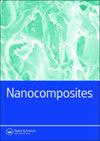Monometallic and bimetallic SiC(O) ceramic with Ni, Co and/or Fe nanoparticles for catalytic applications
IF 4.2
3区 材料科学
Q2 MATERIALS SCIENCE, COMPOSITES
引用次数: 2
Abstract
Abstract Monometallic (Ni, Co or Fe-SiC(O)) and bimetallic (Ni, Co or FeM-SiC(O) with M = Ni or Co) ceramic nanocomposites have been successfully prepared using polymeric precursors obtained by chemical modification of polycarbosilane with metal acetylacetonate. The nanocomposites consist of homogeneously distributed metal nanoparticles within an amorphous SiC(O). The specific surface area (SSA) of Ni, Co or Fe-SiC(O)600 nanocomposites were found to be 155, 50 or 14 m2/g. However, the addition of Fe to the Ni-or Co-containing precursors tends to increase the SSA to 290 or 170 m2/g. Maximum CO2 conversion for monometallic samples was found to be 40% at 500 °C for Ni-SiC(O)600 and maximum CH4 selectivity was 61% at 300 °C for Co-SiC(O)600. The additional presence of Co and Ni in the respective nanocomposites helps to increase the CO2 conversion and selectivity at 500 °C whereas Fe modification shows high methane selectivity at lower temperature < 350 °C. Graphical Abstract Highlights Novel nanocomposites consist of bimetallic and SiC(O) ceramic with high specific surface area (SSA) for catalytic applications synthesized via polymer-derived route. Homogeneously distributed metal nanoparticles (5–7 nm) within amorphous SiC(O) ceramics. Among monometallic composites, Ni-SiC(O) and Co-SiC(O) show better catalytic results in methanation reaction than Fe-SiC(O). Introduction of second metal (Ni, Co or Fe) into Ni and Co-SiC(O) ceramic nanocomposites enhances the SSA and catalytic activity in methanation reaction. In bimetallic nanocomposites Ni and Co increase the catalytic activity and selectivity whereas Fe helps to improve the selectivity at lower temperature.单金属和双金属SiC(O)陶瓷与Ni, Co和/或Fe纳米颗粒催化应用
摘要用金属乙酰丙酮酸对聚碳硅烷进行化学改性,制备了单金属(Ni、Co或Fe-SiC(O))和双金属(Ni、Co或M = Ni或Co的FeM-SiC(O))陶瓷纳米复合材料。纳米复合材料由均匀分布在非晶SiC(O)中的金属纳米颗粒组成。Ni、Co和Fe-SiC(O)600纳米复合材料的比表面积(SSA)分别为155、50和14 m2/g。然而,在含镍或含钴前驱体中添加铁会使SSA增加到290或170 m2/g。在500℃时,Ni-SiC(O)600对单金属样品的最大CO2转化率为40%,在300℃时,Co-SiC(O)600对CH4的最大选择性为61%。Co和Ni在纳米复合材料中的额外存在有助于在500℃时提高CO2转化率和选择性,而Fe改性在较低温度< 350℃时显示出较高的甲烷选择性。新型纳米复合材料由双金属和具有高比表面积(SSA)的SiC(O)陶瓷组成,通过聚合物衍生的途径合成了具有催化应用的纳米复合材料。非晶SiC(O)陶瓷中均匀分布的金属纳米颗粒(5-7 nm)。在单金属复合材料中,Ni-SiC(O)和Co-SiC(O)在甲烷化反应中的催化效果优于Fe-SiC(O)。在Ni和Co- sic (O)陶瓷纳米复合材料中引入第二金属(Ni、Co或Fe)增强了甲烷化反应的SSA和催化活性。在双金属纳米复合材料中,Ni和Co提高了催化活性和选择性,而Fe则有助于提高低温下的选择性。
本文章由计算机程序翻译,如有差异,请以英文原文为准。
求助全文
约1分钟内获得全文
求助全文

 求助内容:
求助内容: 应助结果提醒方式:
应助结果提醒方式:


